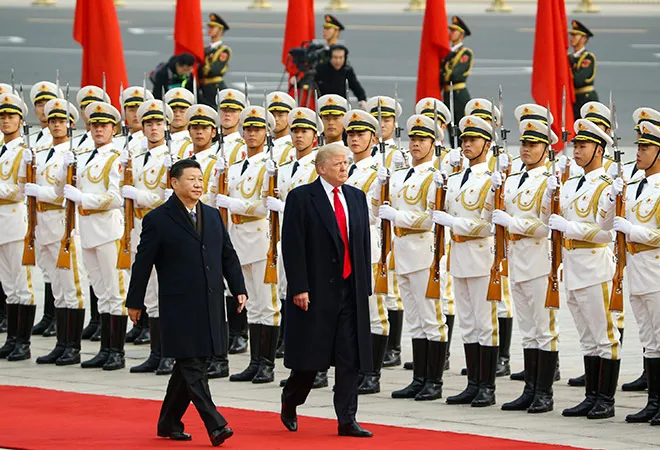
If you can ignore the noise surrounding the Trump Administration, one of the most significant developments of 2018 in the United States is the broad institutional response to the challenge of China developing across the government.
Relevant US agencies are working to devise appropriate measures to fashion a whole-of-the-government response. But given the chaos associated with Donald Trump’s presidency, the worry about dysfunction tends to obscure the functions.
The lines for the new Cold War are being clearly drawn. Starting from the release of the National Security Strategy in December 2017, which named China as a strategic competitor, to the unveiling of the Indo-Pacific strategy, to the creation of a new federal agency to finance development, to Vice President Mike Pence’s speech on China at the Hudson Institute to the passing of the Asia Reassurance Initiative Act or ARIA in December 2018 by the US Congress, the trajectory is apparent as is the reversal of decades of American thinking on China.
Compulsions of economic interdependence with China may yet prompt Trump to make some accommodation with Beijing. The White House debate between economic nationalists and globalists on the merits of a trade war with China continues.
Soybean farmers are hurting, prices of consumer products are rising, and the mainstream media – convinced of Trump’s follies – is bringing the pain home to voters.
Private sector companies, while exhausted by China stealing their intellectual property and playing unfairly, want steps taken to punish China but painless, invisible steps so they can slide back into the vast Chinese market when the time is right.
What Trump does before the next election is anyone’s guess. But enough measures are being taken across government to deter, block and punish China. The resignation of Defence Secretary Jim Mattis was a setback, no doubt, but the broad direction of policy is expected to endure.
The changes are embedded in legislative measures and supported by both the Democrats and Republicans, which means things won’t return to the old normal with a change in leadership. The response to the perceived threat from China is bipartisan.
There is widespread recognition that the rise of China and its refusal to play by the existing rules has shaken US allies, gravely undermined the World Trade Organisation and thrown up questions to which answers must be found.
The US has taken steps and 2018 can be seen as the year of putting together resources and fashioning tools to push back. This should give confidence to India and others in Asia as they evolve their own policies and responses to try to balance China’s formidable rise.
Pence’s speech in October called China out for its economic aggression, influence operations, expansionist policies and military adventurism. It was as good a public admission as any that previous policies of cooperative persuasion have failed.
The CIA’s top China expert, Michael Collins, told the Aspen Security Forum this summer that Xi Jinping’s China is engaged in a “systems conflict” with the US. “What they are waging against us is fundamentally a cold war” and far more significant than what the Russians did.
The FBI director Christopher Wray said China had a “whole of society” strategy for the US and the rest, which requires a similar response ning all segments of government and society.
The US is trying to reduce technological dependency on China by limiting Chinese investment, sharing intelligence information with the Europeans to launch cases against Chinese companies and executives. New regulations on dual use technology are designed to prevent easy access by Chinese actors.
Economic decoupling -- if only in the tech sector and by implication in the defence sector -- will be slow. That will give other countries time to make choices but not too much.
The US has also begun denying easy exploitation of its open system. China’s various propaganda arms are being tied in rules and regulations. After a steady barrage of criticism against Chinese government-paid inserts in US newspapers, China’s state-run news agency Xinhua was asked to register with the US Justice Department as a “foreign agent” just like lobbyists working for foreign government do.
Xinhua can no longer operate as a “news” agency. Several lawmakers have accused Xinhua of using its bureaus in the US to collect intelligence.
But perhaps, the most important signal out of Washington in 2018 was the passage of ARIA, a bill that attempts to counter Chinese hegemony and covers US relations with India, Japan, South Korea, the Pacific Islands and the ASEAN countries among others.
It is an attempt to develop a “long-term strategic vision and a comprehensive, multifaceted and principled United States policy for the Indo-Pacific region.” Everything from promotion of democracy to cyber security, combating terrorism to protecting intellectual property is covered.
ARIA authorizes $1.5 billion every year to be appropriated for the next five years for enhanced diplomatic and economic assistance to countries of the region. While it’s not a huge sum when spread across the Indo-Pacific, it’s a start and an improvement on the rhetorical flourishes of the Obama Administration.
The idea is to improve capacity in defence so nations can “resist coercion” and codify the policy on regular freedom of navigation and overflight operations in the Indo-Pacific region.
Both the Senate and the House have passed their versions of ARIA, with the conference committee trying to resolve differences. Trump is expected to sign it into law.
With that, a new phase is expected to begin with the US strengthening relations with allies and partners, including India. The question is whether New Delhi can seize the opportunity and make its hand stronger in the balancing game.
The views expressed above belong to the author(s). ORF research and analyses now available on Telegram! Click here to access our curated content — blogs, longforms and interviews.




 PREV
PREV


